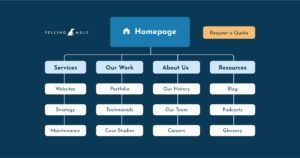
The blueprint necessary for a site’s prime organization and optimization – a Sitemap. In this blog, we discuss sitemap basics, what the Yelling Mule process looks like, and the benefits of strong map development.
A sitemap – the filing system used within a site – determines the navigation of the website and the key pages that will be featured. Typically, a website navigation structure is similar to a family tree, containing parent pages, child pages, grandchild pages, ancestors, and descendants. A parent page covers an overall theme that groups child pages. To access child pages, they must be clicked into.
As shown above, we include four parent pages within the Yelling Mule site navigation, including: “Services”, “Our Work”, “About Us”, and “Resources”. Each of these are home to child pages. For example, “Our History” is a child page shared by the parent page “About Us”.
This family-tree style of navigation is important for the website’s SEO and URL structure. In a family tree, in order for there to be children, there must be a parent. With websites, if a child page doesn’t have a parent page, the URL path is less helpful, ultimately increasing the risk of poor user experience, incorrect site indexing, and poor SEO. When created efficiently, sitemaps can enhance search engine crawling. Search engines can accurately host results when data is specified within a sitemap.
We introduce a sitemap directly after our first meeting with the client. We require clients to approve the sitemap before we begin designing the homepage and site interiors. Once this is approved, the client may begin supplying the content necessary for each page.
Looking to learn more about our process? Check out our other web design blogs.

